Scroll down to view highlights of the Allis art collection, or filter your viewing by material, period or artist below.
Considered a reflection of a family’s wealth and taste, art collecting has been a pastime of the social elite for centuries. So, it’s hardly unusual that one of Milwaukee’s most influential industrial families collected important work from around the world.

Scroll down to view highlights of the Allis art collection, or filter your viewing by material, period or artist below.
Material: Watercolor
Artist: Homer
Origin:
Size: 7 x 16 inches
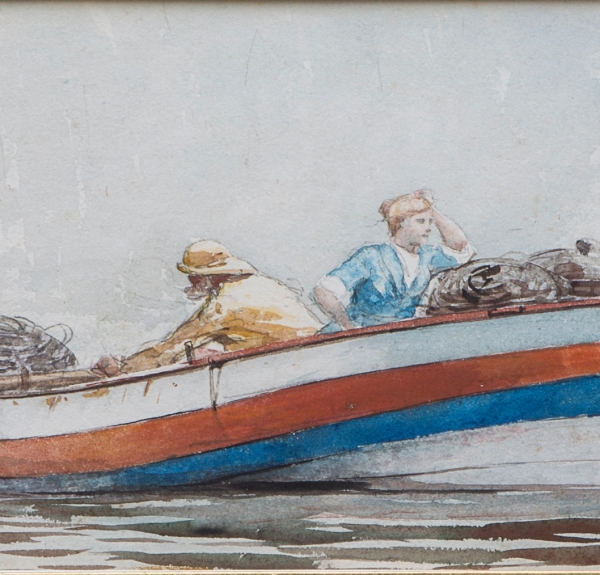
* Click To Enlarge
* Click To Enlarge
This pointing references the working people Winslow Homer saw on a daily basis on the East Coast. His attention to detail in this watercolor is impeccable, enticing the viewer to take a deeper look at the scene he has depicted.
Homer is known to have painted en plein air (in open air, or outside), and the view in front of him would have often included boats, fishermen and women at work. His works capture the dignity and power of working people. In this painting, the boat and figures are clouded with mist, as they would be when going out early in the morning to fish. The fisherman's face is turned away from the viewers, as he is rowing the rowboat, while the woman looks onward into the distance. The sleeves of her blue dress are rolled up to her elbow, indicating her involvement with the work on the boat.
Charles and Sarah Allis purchased this painting from the Macbeth Gallery in New York City in 1912.
Winslow Homer (American, 1836–1910) is considered by many to be one of the greatest American artists of the late nineteenth century. He is known particularly for his love of the sea, the realism of his works, and for his versatility as an artist.
Beginning his career in Boston, Massachusetts — where he worked for a newspaper as a lithographer (a printmaker whose methods involve using heavy stones to press the plate and paper together) — Homer also worked for Harper's Weekly in New York, which sent him to the front lines of the Civil War to sketch soldiers and battles for publication in the magazine.
Following the war, his art included studies of women at work and children at play. He spent more than a year in England in the early 1880s, living in a small town on the North Sea; there he was able to observe firsthand the work of the townsfolk as they waited for the men to return from fishing. Upon his return to the United States, he moved from New York to Prouts Neck, Maine, where he lived until his death in 1910. His art reflected his passion for the sea in all its drama and wildness. His seascapes remain the most admired of his works.
Period: Meiji (1868-1912)
Material: Ceramic
Artist: Yabu Meizan
Origin: Japanese
Size: 5 x 3 inches
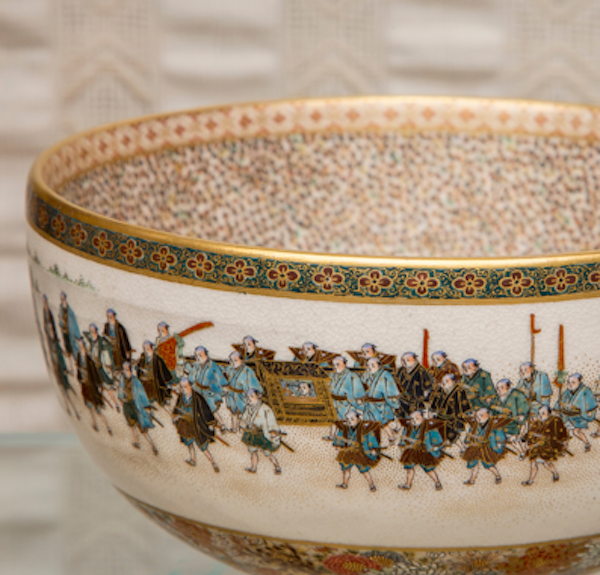
* Click To Enlarge
* Click To Enlarge

* Click To Enlarge
* Click To Enlarge
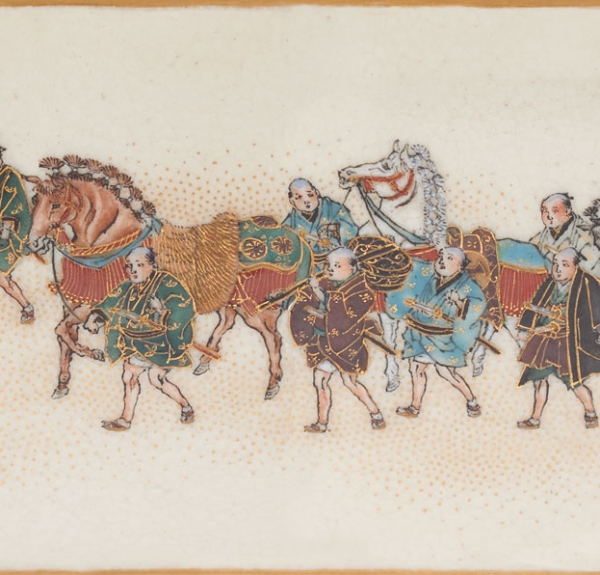
* Click To Enlarge
* Click To Enlarge
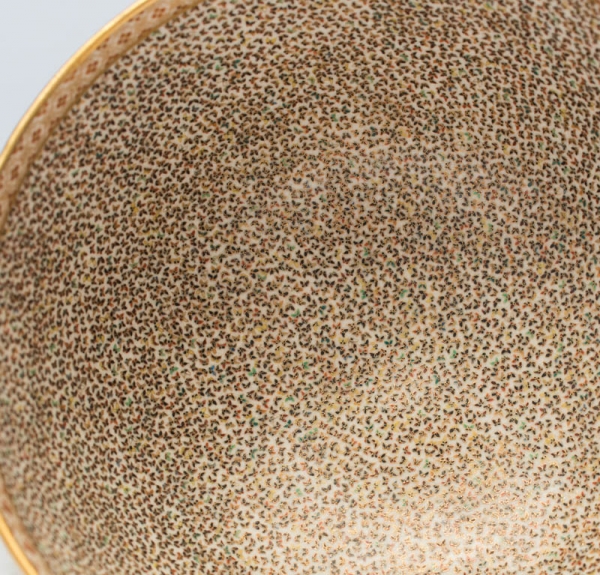
* Click To Enlarge
* Click To Enlarge
The outside of the bowl illustrates the Mikado’s birthday outing; he rides in a palanquin (a covered litter carried by four men) with a procession of walking Samurai and guards, their horses with empty saddles, including the emperor's white steed. While the Mikado rides in his palanquin, the others walk as to not look down upon him from their horses.
The palace walls are in the distance, and a trail of flowers are scattered beneath them.
The inside of the bowl is decorated with four thousand minuscule butterflies, barely recognizable with the naked eye.
On view in the Marble Hall.
Period: Meiji (1868-1912)
Material: Ceramic
Artist: Unknown
Origin: Japan
Size: 4.25 x 9.5 inches

* Click To Enlarge
* Click To Enlarge
Known as the “Vase of a Thousand Faces,” this intricately decorated vase is one of the highlights of the Allis' Asian art collection. This unsigned vase is of the highest quality. Not only are the one thousand faces impressive, the foot and neck of the vase are beautifully painted in gold, coral, turquoise, green, and blue.
On view in the Marble Hall.
Period: Sixth century B.C.
Material: Ceramic
Artist: Unknown
Origin: Persian
Size: 6.75 x 3.25 inches
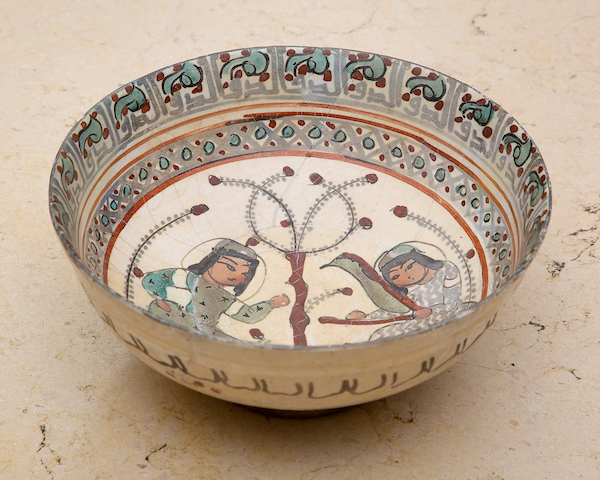
* Click To Enlarge
* Click To Enlarge
This ornate Persian bowl was found in Rhages, Iran and dates back to the sixth century B.C. It’s decorated with a polychromatic design, showing two musicians sitting by a tree, one playing the guitar. The rim of the bowl is lined with Arabic inscriptions.
Charles Allis often corresponded with art professionals at the Art Institute of Chicago and the Field Museum to make sure works he was interested in buying were authentic. On June 13, 1916, Dr. Frank W. Gunsaulus — a board member of the Art Institute of Chicago — favorably compared this Persian bowl to one in the Art Institute’s collection, saying he was particularly charmed with its perfect condition and design. Gunsaulus declared it absolutely genuine and one of the finest specimens he had ever seen.
This bowl was originally in the collection of Mirza Ali Ekbar of Tehran. Charles Allis purchased the bowl in Tabbagh in 1916.
Period: Chien Lung (1736-1795)
Material: Wood, Cloisonné
Artist: Unknown
Origin: Chinese
Size: 64 x 60 x 2 inches
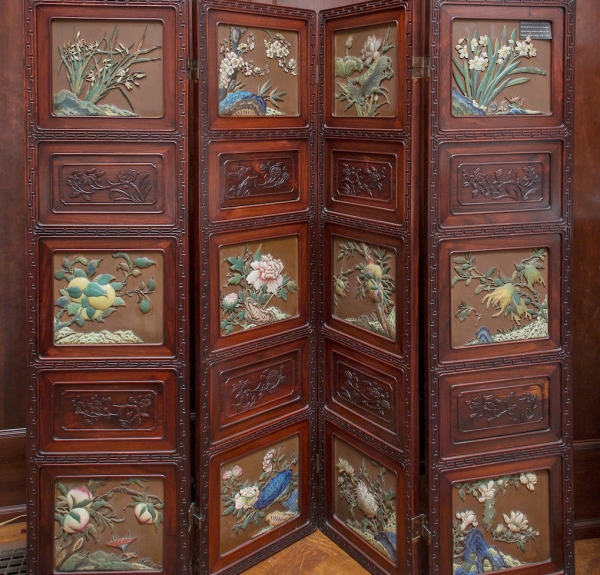
* Click To Enlarge
* Click To Enlarge
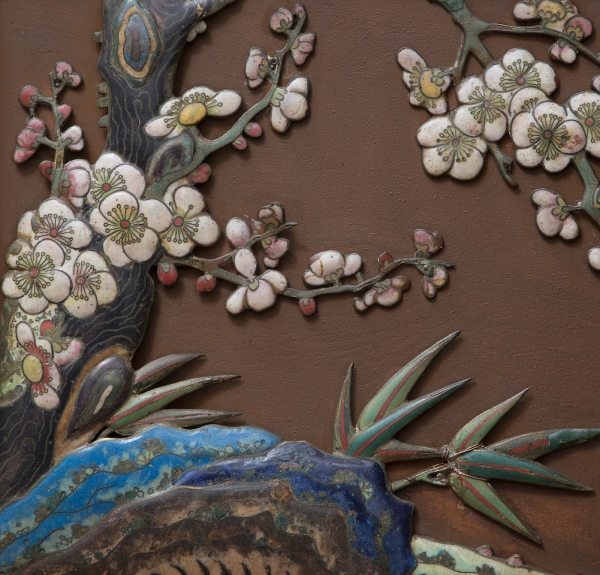
* Click To Enlarge
* Click To Enlarge
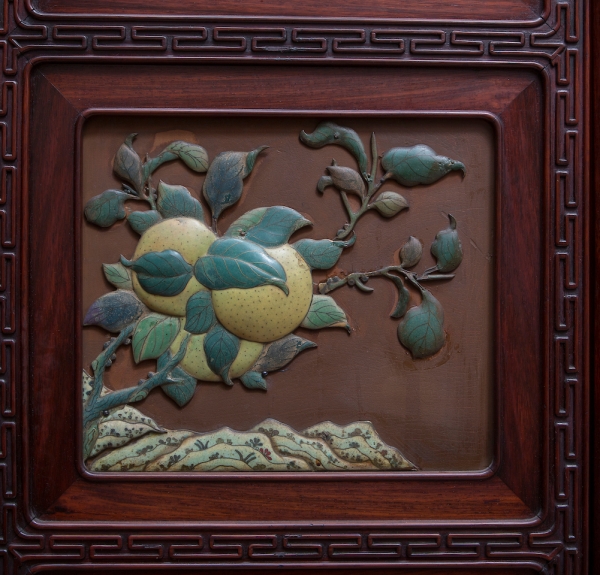
* Click To Enlarge
* Click To Enlarge
This four-fold Chinese carved teakwood screen is composed of sections that are 16 inches wide by 60 inches high. There are 12 panels, each measuring 9.5 x 11 inches, of raised openwork cloisonné floral designs applied on a brown background, representing the 12 months of the year.
The flowers of the months are as follows:
January: Plum. An old Chinese saying has it that the pine, bamboo and plum are like three friends because they keep green in cold weather. The plum is also an emblem of longevity.
February: Peach Blossom. The peach is an emblem of longevity. The peach tree is described in ancient books as the tree of the gods, yielding the fruit of immortality.
March: Peony. The peony was considered the “King of Flowers,” indicating the esteem in which it was held. It is a symbol of love and affection.
April: Cherry. The cherry is an emblem of prosperity, and budding flowers express the wish for good fortune.
May: Magnolia. This flower is an emblem of sweetness and beauty. Its name in Chinese means “secretly smiling,” as it suggests the loving smile of a sweet maiden.
June: Pomegranate. This fruit is a Buddhist symbol representing the essence of favorable influences believed to exist in the pomegranate tree.
July: Lotus. This flower is a symbol of purity, because it springs from the water without contact with the sordid earth. No matter how muddy the water may be, the lotus preserves its beauty undefiled.
August: Pear. The pear serves as a guard against evil spirits, and boughs of pear trees are placed in doorways to prevent the entry of evil spirits.
September: Mallow. This is a symbol of longevity and immortality.
October: Chrysanthemum. This flower is a symbol of mid-autumn and also of joviality.
November: Gardenia. This flower is an emblem of marriage and happiness.
December: Poppy. This flower is raised for the beauty of the blossoms as well as the production of opium. It is a symbol of riches and earthly success.
On view in the Marble Hall
Material: Wooden Panel, Oil
Artist: Díaz de la Peña
Origin:
Size: 10 x 13 inches

* Click To Enlarge
* Click To Enlarge
In this painting by Narcisse Virgilio Díaz de la Peña (French, Bordeaux 1801–76), we get a glimpse of forest that was so central to the Barbizon painters. Through an opening in the dense foliage of the forest, which completely cuts off a view of the sky, a group of large birch trees is seen, their white trunks gleaming in the sunlight, which bathes the middle distance of the picture. The trees and the figure of a peasant woman gathering wood are reflected in a quiet pool of water.
Díaz de la Peña was a painter of the Barbizon School. He was born in Bordeaux to Spanish parents who had fled the Peninsular Wars. After their early deaths, Diaz grew up in foster care in Meudon. He spent his youth copying paintings at the Louvre. He admired Théodore Rousseau, and eventually became Rousseau’s student, painting at the Forest of Fontainebleau. He is known for his landscapes, which often included peasants and musicians, following a tradition of eighteenth-century decorative landscapes, and for his depictions of storms. He first exhibited at the Paris Salon in 1831, and continued to exhibit there throughout his life.
Material: Wooden Panel, Oil
Artist: Rousseau
Origin:
Size: 6.5 x 9.5 inches

* Click To Enlarge
* Click To Enlarge
This painting by Theodore Rousseau (French, 1812–67) is a landscape with a small stream of water in the center and a figure of a woman with a wooden yoke carrying two buckets of water. To the left, a cottage is seen among the trees.
Rousseau was born in Paris. Around the age of 14, he took up painting after being inspired by a journey to the beautiful and mountainous Jura region of France. His parents then sent him to study with the landscape artist Alexandre Pau de Saint-Martin, a cousin of Rousseau’s mother. After that, Rousseau began training under the artists Joseph Rémond and Guillaume Lethière, but he found their styles too tradition-bound. He left them and he started painting outdoors within the city rather than in the studio.
In 1830, Rousseau, then 18 years old, began to travel farther beyond the city to work from nature. He gravitated to the village of Barbizon, where he focused his eye on the Forest of Fontainebleau. By 1844 he had moved to Barbizon, and become a central figure in the Barbizon School. He was a committed naturalist, often working on a single piece for more than a year. Along with Corot and Daubigny, Rousseau is said to have been an influence on the emerging Impressionists.
Like many of his fellow Romantics, Rousseau was excluded from the Paris Salon for a number of years in the late 1830s and 1840s because the Salon still favored Neoclassicism. After the Revolution of 1848, however, Rousseau was accepted; in 1849, he exhibited three paintings and won a first-place medal.
Period: 1800s
Material: Oil, Canvas
Artist: Strin
Origin:
Size: 26.5 x 19 inches
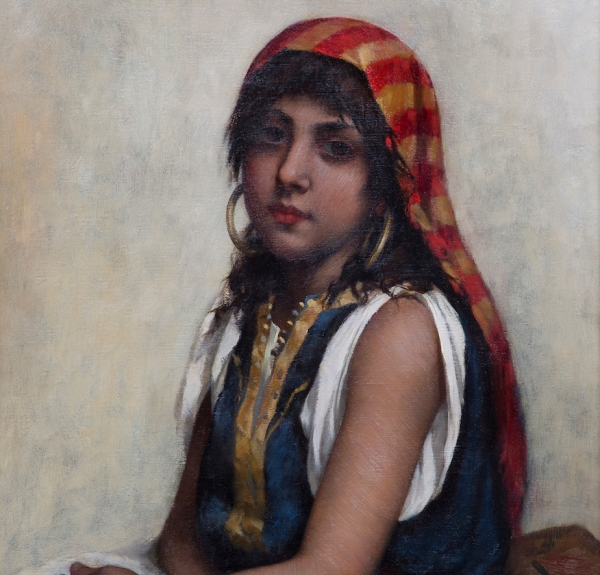
* Click To Enlarge
* Click To Enlarge
The subject of Daniel Strin's oil painting is an Egyptian girl with a red and gold striped scarf over her dark hair. She is wearing a gold bracelet and earrings, and a white dress with a navy blue with gold trim vest. The painting is signed and dated 1884 in the lower-right corner.
Charles purchased the work from the subject's father, who had bought it from the artist.
Period: Edo (1602-1868)
Material: Earthenware
Artist: Seikun
Origin: Japanese
Size: 18 x 26 inches
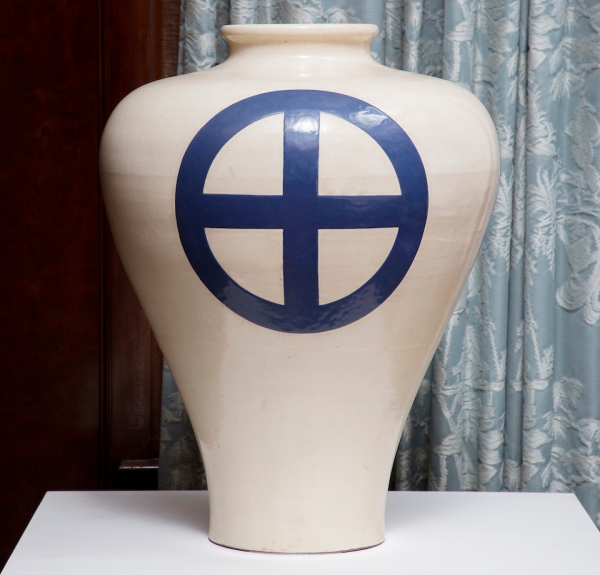
* Click To Enlarge
* Click To Enlarge
This Japanese earthenware vase is of the Satsuma type — the ware was named for the old province in which it was produced. It’s decorated with three large blue Mon (badges) of the Shimazu family, the feudal lords of the province of Satsuma. The Shimazu family controlled the production of pottery in Japan from the end of the sixteenth century, when a family member returning from an invasion of Korea brought with him 17 skilled Korean potters. They built kilns and produced ceramics for the exclusive use of the powerful family; this workshop continued throughout the seventeenth and eighteenth centuries.
This particular Satsuma vase, of spectacular size and perfect form — which is extremely difficult to achieve in large pieces like this — was evidently made for the Shimazu family. It is marked on the underside “in the third year of the Kansei Era, the year of boar [1791], Seikun produced this.”
Period: 1800s
Material: Wooden Panel, Oil
Artist: Daubigny
Origin:
Size: 6.5 x 13.5 inches

* Click To Enlarge
* Click To Enlarge
Charles-François Daubigny (French, 1817–78) has depicted a single row of apple trees in blossom, shown in perspective, leading off to the horizon at the left. The row of trees forms a dividing line between two fields, which are shown dotted with bright colored poppies.
Daubigny was one of the great French landscape painters of the second half of the nineteenth century. He is considered a transitional figure between the Barbizon School and the Impressionists. His paintings are almost always horizontal, and known for their depiction of reflected light and their peaceful quality.
Daubigny was born into a family of artists, and first instructor was his father, the classical landscape painter Edmond-François Daubigny (1789–1843). His subsequent training included an apprenticeship with an engraver, and a year in Italy studying Old Masters. Returning to France in 1836, he first exhibited at the Paris Salon in 1838, at the age of 21.
During Daubigny’s early period, he associated with the Barbizon School painters. He met Camille Corot in 1849, and spent some summers painting with him in the Forest of Fontainebleau. Daubigny favored river scenes, however, and left Fontainebleau for the area near Auvers-sur-Oise, where he could paint scenes of the Seine or the Oise. He even had a small ferry (named “Le Botin,” the little box) refitted as a floating studio. Though still associated with the Barbizon School, in his later years Daubigny was known for painting his initial impressions directly onto the canvas, without a prior sketch. This style of direct painting is considered a bridge to Impressionism, with its freer brushwork. He came to know and influence Claude Monet, and was an early supporter of the Impressionists, advocating for their inclusion in Salon exhibitions.
Material: Wood, Marble
Artist: Unknown
Origin:
Size: 19.5 x 23.5 inches
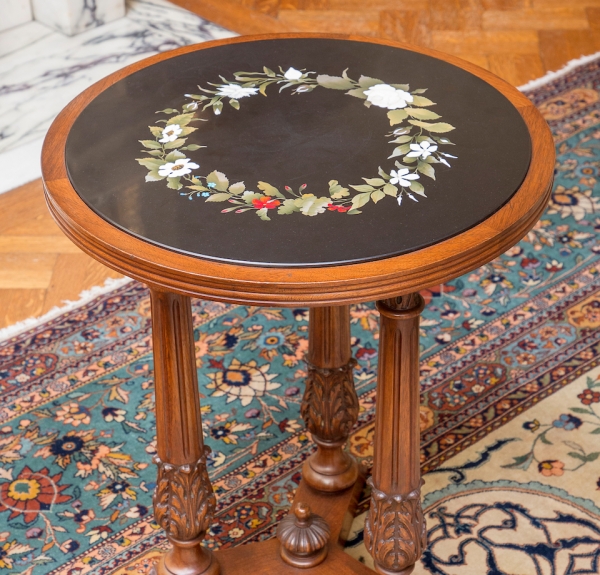
* Click To Enlarge
* Click To Enlarge
This table features a medallion top of black marble inlaid with a flower garland of semi-precious stones. The medallion was originally framed and hung in the home of Elizabeth Camp, sister of Sarah Allis. It was later gifted to Sarah, who had the table built to fit the top.
Period: 1800s
Material: Oil, Canvas
Artist: Inness
Origin:
Size: 15.5 x 20 inches
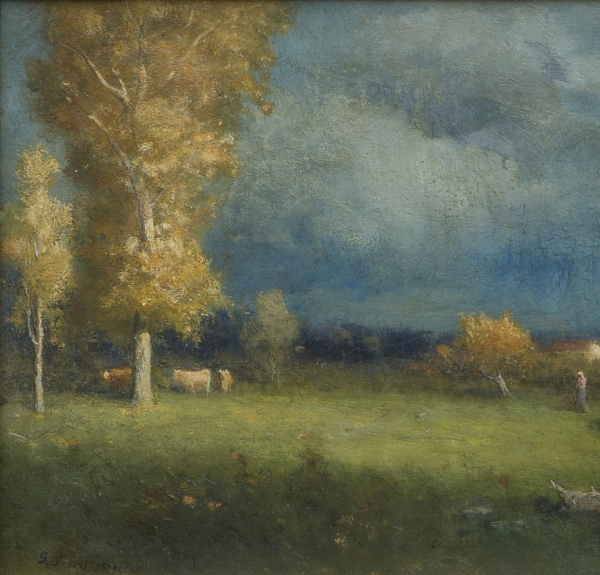
* Click To Enlarge
* Click To Enlarge
George Inness (American, 1825–94) has painted a landscape with sunlit trees in autumnal foliage in the middle foreground. The distance is still in the shadow of the storm clouds, which show in the sky. There are three cows under the trees to the left, and the figure of a woman is at the right, advancing with a pail in her hand. In the distance, a small, white cottage with a red roof is touched by the sun.
The painting is signed in the lower left corner. Charles Allis purchased this painting from M. Knoedler & Company, through W. H. Dicks in 1912.
Inness was a leading nineteenth-century landscape artist who grew up in the Hudson Valley in a time when Hudson River School artists dominated American landscape painting. As an artist, he was drawn to the lofty ideals of Thomas Cole (1801–48) and the intimacy of Asher B. Durand’s (1796–1886) landscapes. Inness was a Hudson River School artist in his early years. Ultimately, however, he distinguished himself from that group, taking inspiration from Théodore Rousseau, the artists of the French Barbizon School, and the spiritualism of the eighteenth-century philosopher-mystic Emanuel Swedenborg.
In the United States, Inness lived and painted primarily in Pennsylvania, Massachusetts, and New Jersey; he also spent several years in Europe in the 1850s and 1870s, studying and painting. He was a committed abolitionist and believer in social reform. He is often associated with the Tonalists, late nineteenth-century artists such as James Abbott McNeill Whistler (1834–1903) and Dwight William Tryon (1849–1925) who worked with a dark, neutral palette.
Period: 1800s
Material: Oil, Canvas
Artist: Moran
Origin:
Size: 10.5 x 16.5 inches
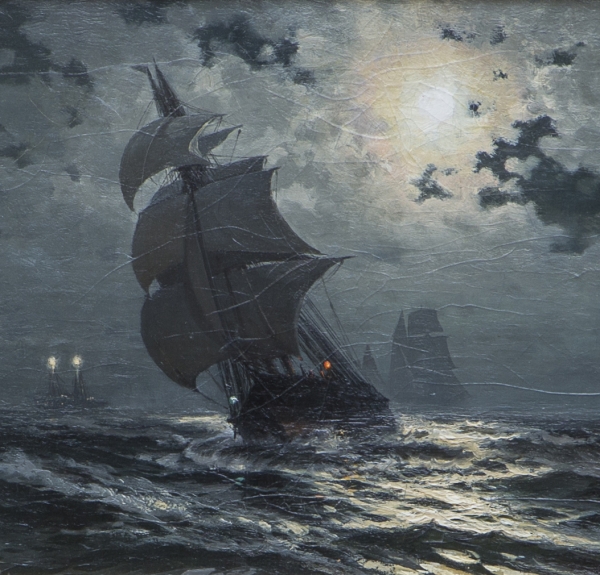
* Click To Enlarge
* Click To Enlarge
In this painting from 1876, notice the impeccable details that Edward Moran (English-born, American, 1829–1901) put into the ship in the foreground, the sails billowing with the ropes attached. If one’s eye follows the ropes to the ship, there is a visible light source that illuminates the face of a person on board. Moran uses tight brushstrokes, which makes it almost impossible to see the hand of the artist, except for the waves that are lit by the moon that is showing through the break in the clouds. The waves that are highlighted by moonlight show thick impasto — a heavy buildup of paint — and give a sense of the rough sailing conditions.
Edward Moran was one of the nineteenth century’s foremost marine artists. He was the brother of Thomas Moran, a better-known painter and printmaker of the Hudson River School who is also represented in the Allis collection.
Moran’s inspiration may lie in the fact that at the age of 15, he and his family (including his brother Thomas) sailed to America and settled in Maryland. This exposure to large ships could have influenced the young Moran greatly. He is best known for his series of 13 paintings representing important epochs in marine history in the United States.
Period: 1800s
Material: Oil, Canvas
Artist: Bonheur
Origin:
Size: 12.5 x 9 inches
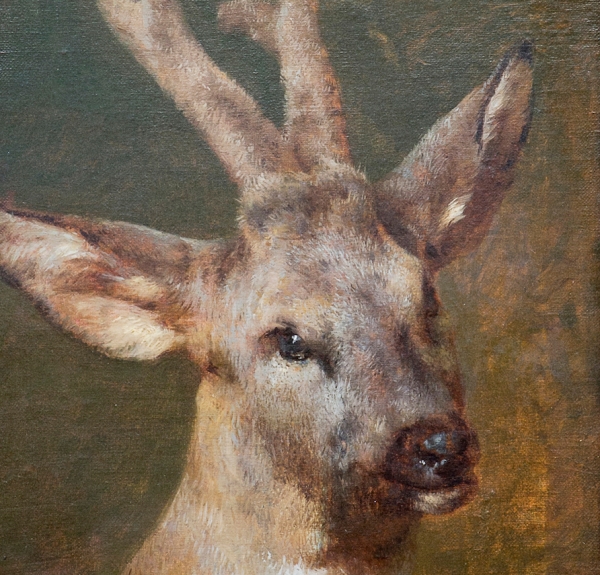
* Click To Enlarge
* Click To Enlarge
In this painting, Rosa Bonheur (French, 1822–99) draws close to her subject, a reddish-brown European stag. She plays with tonal qualities as she places the head of the animal in front of a dark background. The painting is simple, but powerful; her attention to detail and tight, painterly brushstrokes allow the viewer to study the roebuck as if it were a specimen. Drawing in this closely to the deer, Bonheur conveys the feeling that we are looking at a portrait.
Bonheur was born in 1822 in Bordeaux, and moved seven years later to Paris. Her parents believed in women’s education, and she received her art training from her father, landscape painter Raymond Bonheur. She was unconventional in her ambitions and personal life — for instance, Bonheur was the first Parisian woman to get police permission to dress as a man (to wear pants) within the city limits. It was a practice she defended as necessary for her study of animals at slaughterhouses and animal fairs. Bonheur was traditional in her working method. She studied her subjects carefully and produced many preparatory sketches before putting paint to canvas.
Bonheur’s reputation for unusually realistic depictions of animals grew steadily in the 1840s, and she exhibited her animal paintings and sculptures regularly at the Paris Salon, which favored traditional work, from 1841 to 1853. In 1845, Bonheur won a third prize at the Salon, and in 1848, a gold medal.
Her most famous work is "Horse Fair" (1853), which hangs in the Metropolitan Museum of Art.
Period: 1600s
Material: Bronze
Origin:
Size: 24 x 8 x 8 inches
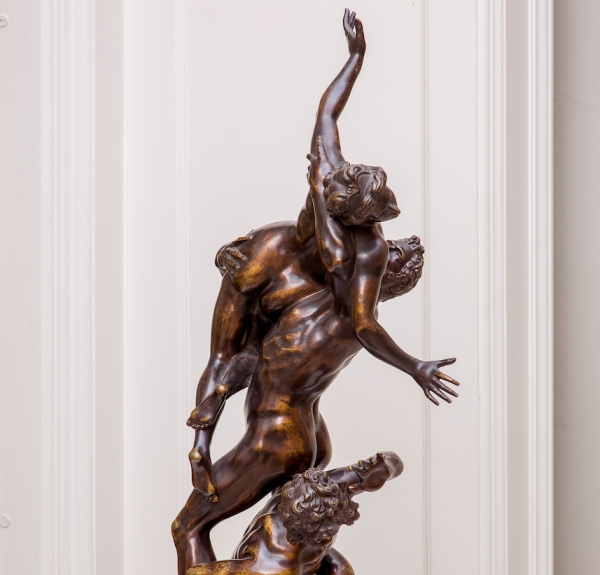
* Click To Enlarge
* Click To Enlarge
This sculpture, dated c. 1680, was made from a model done by Giambologna (Flemish/Italian, 1529–1608) in preparation for his "Rape of the Sabine Women" in Florence’s Loggia dei Lanzi in the Piazza della Signoria. That monumental statue was carved from a single block of marble, and has three intertwined figures spiraling upwards: a woman trying to escape the clutches of a man who stands over another man. Giambologna may have been illustrating a legendary aspect of the founding of Rome in 753 B.C. In order to populate the region quickly, it was said that Roman men acquired wives by abducting the women of neighboring Sabine families. In this context, the Latin word “raptio” is better translated as abduction, not rape. The Sabine men were powerless to save their women; they are represented by the man struggling at the bottom of Giambologna’s statue. Giambologna’s workshop continued to produce sculptures based on his work after his death, and this sculpture is likely an example of that practice. This bronze was previously owned by the Duke of Cambacérés.
Giambologna — born Jean Boulogne in Flanders — became one of the most important sculptors in Italy in the second half of the sixteenth century. He was known for his elaborate marble and bronze statuary, ranging from very large marble statues for fountains to small bronze sculptures.
Giambologna settled in Florence in 1553. His first major commission came from Pope Pius IV, and he was court sculptor to the Medici family. In 1563, he was named a member of the newly established Accademia delle Arti del Disegno (Academy of Fine Arts). He died in Florence in 1608 and was buried in a chapel he had designed in the Santissima Annunziata.
Period: 1600s
Material: Wood, Red Porphyry
Artist: Unknown
Origin:
Size: 42.5 x 33.25 X 32 inches
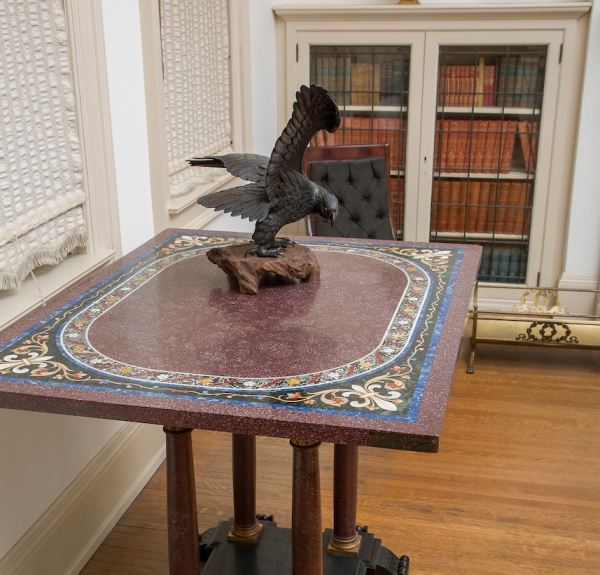
* Click To Enlarge
* Click To Enlarge
This is a seventeenth-century table with a top of Egyptian red porphyry and a mosaic border of conventional floral design in lapis lazuli, jasper and colored agates. The top is supported by four columns of Egyptian red porphyry with carved and gilded wood Corinthian capitals. The columns rest on an ebony base.
The table was purchased in 1916 from the Sangiorgi Galleries in Rome. The gallery describes it as being “from the Palace of the Marquis Toscanelli de Pisa, Italy, which is [known for its] quality and import of valuable marbles, or better, ‘pietre dure.’ [One] can only finds its equal in museums like the Louvre, the South Kensington, or the Ville Borghese.”
Pietra dura or pietre dure is a term for the inlay technique of using cut and fitted, highly polished colored stones to create images. After they’ve been cut, the stones are glued to a substrate so precisely that the gap between the pieces is almost nonexistent. Stability was achieved by grooving the undersides of the stones so that they interlocked, like a jigsaw puzzle, with everything held in place by a frame. Many kinds of colored stones, particularly marbles, can be used, along with semi-precious and precious stones.
Material: Etching
Artist: Buhot
Origin:
Size: 12 x 16 inches
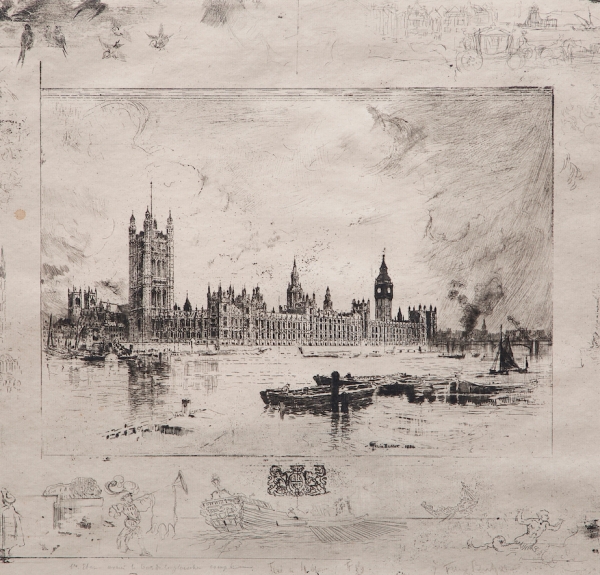
* Click To Enlarge
* Click To Enlarge
Félix Hilaire Buhot (French, 1847–98) engraved this scene. Only four proofs were printed in this state before the plate was cut at the bottom. The writing in the lower margin is that of Buhot.
Léonce Bénédite, a French art historian and curator, had this to say about the work:
"Here Buhot surpasses the mere picturesque and attains the grandeur of style. In the Westminster Palace, under the hazy light of the opaque and heavy sky, near the bank of the dappled waters of the broad and troubled stream, the Houses of Parliament stretch their long, heavy mass of stately blackened buildings, bristling with a multitude of turrets, steeples, and watch-towers, the while proudly dominated by the Victoria Tower and the Clock Tower. It is one of the surest in execution and completest of his works."
This etching was purchased from Frederick Keppel & Company, New York on April 26, 1911.
Material: Watercolor
Artist: Shinn
Origin:
Size: 21 x 17 inches
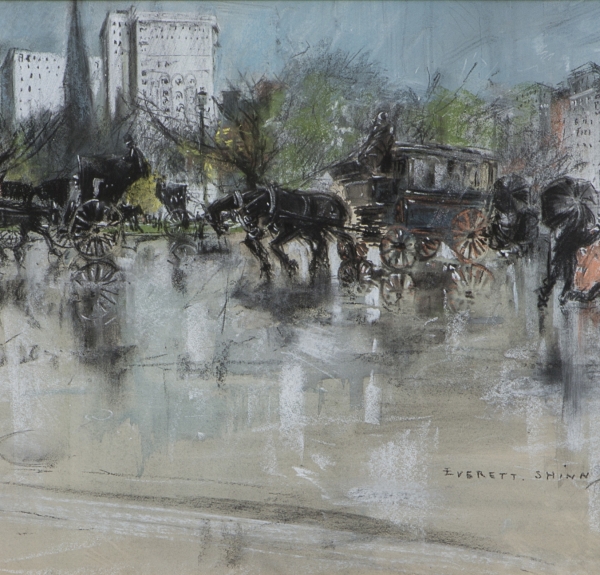
* Click To Enlarge
* Click To Enlarge
This pastel over watercolor washes by Everett Shinn (American, 1876–1953) shows horse-drawn carriages on a rainy day in New York City. There are pedestrians carrying black umbrellas against a background of city buildings. Highlights of coral pink, with spring foliage and blue sky add warmth and beauty to the work.
This painting was purchased from Boussod Valadon & Company in 1902.
Shinn was an American realist painter and member of the Ashcan School. He is best known for his paintings of urban life in New York and London — a distinctive feature of Ashcan art. He also found success painting murals for the theater and in interior design. His style varied considerably over his career, from Ashcan realism to more decorative pieces.